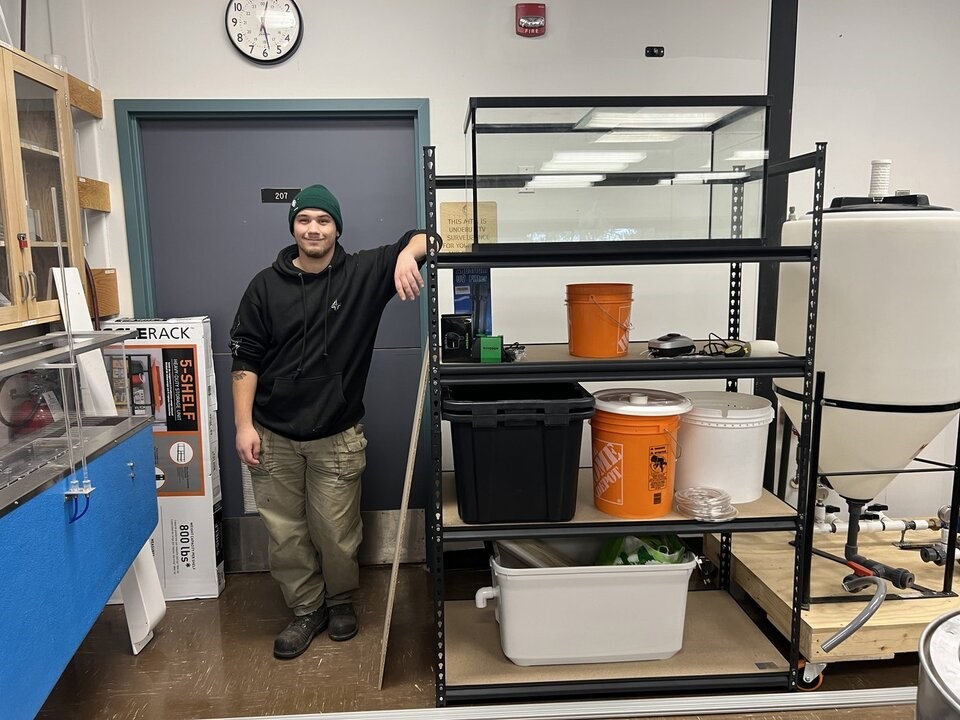By using the waste of Koi fish to grow fresh produce, Vancouver Island University (VIU) engineering student Jayden Corbeil (Iversen) is hoping to improve food supply issues in remote communities with an open-source aquaponics project.
A collaboration with the Haí色zaqv Climate Action Team from Bella Bella in the central coast of B.C., the Hesquiaht member’s capstone project looks at manufacturing a small-scale, semi-automated aquaponics system. The project will be placed in a classroom at the Bella Bella Community School.
Haí色zaqv Climate Action Team hopes to eventually upscale Corbeil’s proof-of-concept aquaponics system to a larger unit to increase food security for their region.
“The big goal is to remove reliance on external suppliers,” said Corbeil, the 2019 Alberni District Secondary School Valedictorian.
“I don’t want people to have to rely on the grocery store to get food. I don’t want people to have to rely on the barge coming in with their shipments of goods to feed themselves,” he continued. “I would really like to see a future where communities are growing all their own food and if the supply chain is disrupted or we lose contact, it’s not going to put us in a state of starvation.”
Corbeil says the beauty of the aquaponics system is that it’s sustainable, scalable and reliable.
“You can scale these systems down for a hobby system in your house or you could scale it all the way up to an industrial system where you are harvesting hundreds of fish every month and thousands of heads of lettuce every week,” said Corbeil.
He opted to design an aquaponics system with Koi fish in an aquarium rather than growing fish for harvest, largely because of the stigma that is often associated with fish farms.
“Particularly among First Nations communities there is a lot of negative connotations with the idea of farming fish, so for now I’m trying to avoid having any fish for harvest purposes,” said the 23-year-old.
“Koi fish are a very hardy and resilient fish,” he continued. “If the water temperature changes on them by a few degrees, they’re not going to get too upset about that and if they lose air supply for a day, due to a critical malfunction, they’re not going to all die immediately whereas some other fish such as tilapia, salmon or trout are a lot more sensitive to changes in environment.”
Jollity Farm on Thetis Island, part of B.C.’s Gulf Islands, has a commercial aquaponics farm that uses 30 to 50 Koi to help grow roughly 1,800 heads of lettuce.
Farmer Noah Bond says they harvest around 50 pounds of lettuce in a week, which they sell at the Jollity market and at their café in Chemainus.
Jollity is working with Corbeil and Haí色zaqv Climate Action Team on their aquaponics project.
“I think it’s sustainable. Just like anything, you need someone to be aware of what’s going on and be there to check things. I check it twice a day. I don’t have to do too much; you know a session here and there with planting, but after that the upkeep is pretty easy,” said farmer Bond.
He adores the symbiotic relationship he has with the Koi.
“They’re like my buddies. They are kind of working with me and I’m working with them,” he said.
Aquaponics salad tastes a little lighter than lettuce grown in soil, according to farmer Bond.
“I find the leaves are a little lighter. The weight is a little bit lighter and only for the reason because of the minerals. I’m learning every day,” he said, noting that he adds iron to the deep bath that the lettuces float in.
Corbeil started working on the engineering design for his proof-of-concept aquaponics system in early 2024.
Lately, his focus has been on the coding for the semi-automated system.
“There is a microcontroller that is sensing and controlling water levels as well as temperatures for the water and light exposure for the plant beds,” he explains.
But the key to the whole system is the nitrifying bacteria that converts the fish waste into nutrient rich food for the plants.
“It turns all the bad stuff in the water into good stuff for the plants,” Corbeil said.
His aquaponics system is sized to grow eight to 10 heads of lettuce and will cost a maximum of $2,000 in materials. The automation aspect of the project makes the price go up, but Corbeil says it can be replicated for under $200 with parts from a hardware store.
Following graduation next year, Corbeil has his sights set on getting his Canada Lands Surveyor certification so he can contribute to infrastructure development in remote communities and First Nation reserves.



